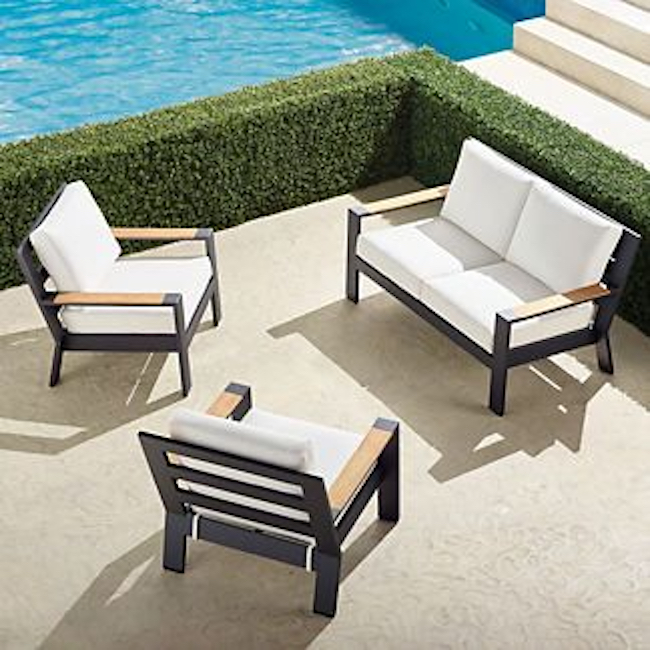How to Best Choose The Right Material For Your Outdoor Furniture

The global outdoor furniture market size is projected to grow annually by 2.56% between now and 2028. This shows just how much outdoor furniture is important for people when creating their oasis.
Making your backyard into an inviting and functional outdoor space can be an exhilarating journey, offering a slice of paradise right in your backyard. To ensure this goal is realized, selecting materials for outdoor furniture that withstand nature while adding beauty to the surroundings is of utmost importance. With such a diverse selection of materials available today it may seem daunting but don’t fret.
In this comprehensive guide, we’ll explore the art of selecting suitable outdoor furniture materials and striking a balance between durability, style, and maintenance requirements. From the classic charm of teak wood to the modern elegance of aluminum, the rustic allure of wicker, and the strength of steel, each material has its unique advantages.
No matter your goal – durability, style, or the perfect blend of both – our insights will equip you to make an informed choice that will enhance your outdoor experience for years. Join us on this adventure as we reveal how the right selection of materials can transform an ordinary backyard space into an oasis of comfort and beauty.
Rattan: Natural Beauty
A material that deserves attention when considering outdoor furniture is rattan. Rattan furniture has gained popularity for its natural, organic look and versatility. Derived from the rattan palm, this material is known for its strength and flexibility, making it ideal for weaving intricate patterns and designs.
Decorating the space with rattan garden furniture can add a touch of casual elegance to any outdoor setting. Natural rattan’s warm and welcoming appearance creates an inviting environment, perfect for relaxation and social gatherings. However, natural rattan should only be placed in covered outdoor spaces with limited exposure to direct sunlight and rainfall.
Synthetic rattan furniture is specially engineered to withstand the elements, constructed from high-grade resin materials that mimic natural rattan’s appearance while remaining resistant to moisture, UV rays, and temperature variations. This type of rattan is easy to maintain and clean, typically requiring just a gentle wash with mild soap and water.
Whether you opt for natural or synthetic rattan, this material exudes timeless appeal and seamlessly blends with various design styles, from coastal to bohemian. Adding cushions with all-weather fabrics can enhance the comfort and style of rattan furniture while protecting it from the elements. With its unique texture and aesthetic, rattan offers an excellent choice for those seeking outdoor furniture that effortlessly combines aesthetics and functionality.
Teak Wood: Timeless Elegance
Teak wood is widely revered for its natural beauty and longevity, making it an excellent material choice for outdoor furniture. As this material naturally resists moisture and insects, long-term outdoor use should not pose any problems. Teak furniture develops a lovely silver patina over time, adding to its charm.
To maintain its original golden hue, regular oiling is recommended. While teak furniture tends to be on the pricier side, its longevity and classic aesthetic make it a worthy investment.
Aluminum: Modern Simplicity

Aluminum outdoor furniture is favored for its lightweight nature and resistance to rust and corrosion. It’s easy to move around and requires minimal maintenance. To enhance its durability, look for furniture with a powder-coated finish, which adds an extra layer of protection. Aluminum furniture often features sleek, modern designs that can complement various outdoor settings. Pair it with weather-resistant cushions for added comfort.
Wicker: Rustic Charm
Synthetic wicker is a popular choice for outdoor furniture due to its rustic appearance and exceptional resilience. Synthetic wicker furniture offers the same stylish appeal and weather resistance as natural wicker but without moisture damage concerns.
Available in an array of styles and colors, synthetic wicker makes finding pieces to complement your outdoor decor easy. Regular cleaning and occasional washing will help maintain its appearance.
Steel: Industrial Strength
Steel outdoor furniture is known for its strength and sturdiness, making it an excellent choice for those seeking an industrial or modern aesthetic. However, steel should be treated to prevent rust, so look for furniture with a rust-resistant coating or finish. Keep in mind that steel furniture can retain heat in direct sunlight, so it’s advisable to use cushions or opt for designs with built-in shade elements.
All-Weather Fabrics: Comfort and Durability
No matter which material is chosen for the frame, quality cushions, and fabric are equally essential. Look for all-weather fabric resistant to fading and moisture for optimal results. Various brands are offering an assortment of fabrics that offer style, comfort, and durability in one product. When not in use, cushions should be stored in an airtight environment for maximum longevity.
Final Thoughts
Finding the ideal materials for outdoor furniture requires striking a delicate balance between style, durability, and maintenance.
Consider factors like your climate of location, preferred aesthetic, and the amount of care and upkeep you are willing to dedicate. No matter the material of choice for your outdoor furniture, be it teak, aluminum, wicker, or steel – making sure that it can withstand the elements will help ensure an inviting and enjoyable outdoor experience for years to come.


